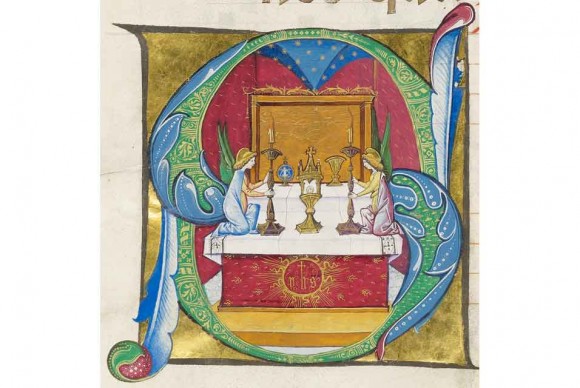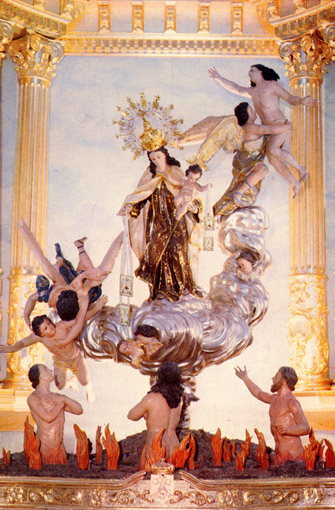
JMJT!
Praise be Jesus Christ! Now and Forever!
I finally took the plunge, and did it. I decided to become a member of our parish choir, after several years of talking about it, and admiring the beautiful melodies that have lifted my soul to God in the pews Sunday after Sunday. Practicing these pieces of music and preparing to sing on Sunday has brought new light to the meaning of holy and sacred music to me. Although a neophyte and in need of plenty more practice, music theory/education, and strengthening of my voice, I feel blessed to be participating in something that creates more beauty within the soul, and praises God without barriers. It was Johann Sebastian Bach himself who said, “Music is an agreeable harmony for the honor of God and the permissible delights of the soul.”
When I sing, I feel free and my soul rejoices in expressing itself with such intensity of emotion and heartfelt love. I feel transparent and vulnerable. We are told by the great Doctor of the Church, St. Augustine, that, "Bis orat qui bene cantat" or the oft-stated, "One Who sings well prays twice." St. Thomas Aquinas tells us in Summa Theologica that, "Music is the exaltation of the mind derived from things eternal, bursting forth in sound."
Indeed. St. Paul exhorts the Ephesians that when they come together to worship, "Be filled with the Spirit, speaking to one another in psalms and hymns and spiritual songs."[Eph. 5. 18ff] It is easy to recognize the hand print of God in the advent of sacred music, the most obvious of which is Gregorian Chant, so named after the Pope St. Gregory the Great, "during whose papacy (590–604) it was collected and codified.Charlemagne, king of the Franks (768–814), imposed Gregorian chant on his kingdom, where another liturgical tradition—the Gallican chant—was in common use. During the 8th and 9th centuries, a process of assimilation took place between Gallican and Gregorian chants; and it is the chant in this evolved form that has come down to the present." [Encyclopedia Brittanica]

Gregorian Chant is also called the "sung Bible' and seeks to plunge us more deeply into spiritual realities beyond the everyday, to promote spiritual intimacy with God, and reveal His gifts and love for each individual and the Church as a whole. Now don't get me wrong. We are not singing Gregorian Chant as a choir for every song, but there is an element of it at each Mass, along with other forms of more recently written sacred music. As I have begun to participate more formally in this part of the liturgy, it has caused me to reflect on the role of music in my life and those of the saints.
When I was very ill a few years ago, I found that a major part of my healing process entailed classical music and chant. It would not only calm and soothe me, but it would order my thoughts. I suffered from severe brain fog and confusion, and when I listened to such music I could feel it realigning my brain synapses and neurons. I would become more clear. Because such music is metered, it is structured and helps the body to get into a peaceful rhythm. There have been many studies on this, but I have experienced it very directly in my own life. A famous study involving chant was carried out by French Physician, Alfred Tomatis, who was a specialist in the function of the human ear. He was called to conduct an experiment with a Benedictine monastery where the monks were suffering from fatigue and depression. Tomatis discovered that a new decree had halted the usual six to eight hours of chanting the monks had previously observed and, within a short time, the monks were unable to perform their duties. When Tomatis suggested re-instituting their daily chanting, the monks recovered quickly and were able to resume their demanding schedule of work and prayers. Tomatis concluded that chanting actually affects the bones of a human being, stimulated at about 2000 Hz. The sounds of chanting, he concluded, are produced literally from the bones, not the mouth.
The Church celebrated the Feast Day of one of my favorite Carmelite [soon-to-be] saints, Blessed Elizabeth of the Trinity just last week on November 8th. At a young age, Elizabeth was an accomplished pianist, renowned in France for her talent. She attended the Conservatory of Dijon from the age of eight, and spent hours every day practicing at the piano. As she matured and sought God, she translated these beautiful, melodious sounds from the piano into the chambers of her heart, the very strings of her soul. She recognized that music creates true beauty outwardly thus bringing the soul to communion with the Holy Trinity, and simultaneously can create an even more beautiful inner symphony when the soul sings for God in an unrestrained hymn of thanksgiving and praise.

“A praise of Glory is a soul of silence that remains like a lyre under the mysterious touch of the Holy Spirit so that He may draw from it divine harmonies; it knows that suffering is a string that produces still more beautiful sounds; so it loves to see this string on its instrument that it may more delightfully move the heart of God…”
-Elizabeth of the Trinity
On November 22nd, the Church will celebrate its patron of music, St. Cecilia. St. Cecilia was said to have sung a song to Our Lord, while she was at her wedding. St. Therese wrote to her sister CÉLINE, October 20, 1893,
"I cannot think without delight of that sweet saint, Cecilia. What an example she gives us! In the midst of a pagan world, in the very heart of danger, at the moment when she was to be united to a man whose love was so utterly of earth, it seems to me as if she should have wept and trembled with fear. But instead, “during the music of the marriage-feast Cecilia kept singing in her heart.36 What perfect resignation! No doubt she heard other melodies than those of this world; her Divine Spouse too was singing, and the Angels repeated in chorus the refrain of Bethlehem’s blessed night; “Glory to God in the highest, and on earth peace to men of goodwill.”37
The Glory of God! St. Cecilia understood it well, and longed for it with all her heart. She guessed that her Jesus was thirsting for souls … and that is why her whole desire was to bring to Him quickly the soul of the young Roman, whose only thought was of human glory.This wise Virgin will make of him a Martyr, and multitudes will follow in his footsteps. She knows no fear: the Angels in their song made promise of peace. She knows that the Prince of Peace is bound to protect her, to guard her virginity, and to make her recompense…. “Oh, how beautiful is the chaste generation!’ 38 [see http://www.pathsoflove.com/pdf/ThereseLetters.pdf]

So touched was St. Therese by St. Cecilia's inner symphony to Our Lord, that she honored her with a poem entitled the Melody of St. Cecilia.
[See http://www.catholicspiritualdirection.org/poemstherese.pdf]
My point is that the beauty of sacred music not only transforms hearts, souls, and lives by listening to its outward resonance with the senses, but can be further enveloped into one's very being interiorly as a prayer, to become a praise of glory to Our Lord, as Bl. Elizabeth was fond of saying. In the same letter to her sister as referenced above, St. Therese revealed her desire for her sister to surrender to the Divine Maestro of our lives, our beloved Jesus. She recognized that if we make a dwelling place of lyrical hymns in our hearts, He will do the rest.
MY DEAR SISTER, - I find in the Canticle of Canticles this passage which may be fitly
applied to you: “What dost thou see in they beloved but a band of musicians in an armed camp?”35 Through suffering, your life has in truth become a battle-field, and there must be a band of musicians, so you shall be the little harp of Jesus. But no concert is complete without singing, and if Jesus plays, must not Céline make melody with her voice? When the music is plaintive, she will sing the songs of exile; when the music is gay, she will lilt the airs of her Heavenly Home….
Whatever may happen, all earthly events, be they happy or sad, will be but distant
sounds, unable to awake a vibration from the harp of Jesus. He reserves to Himself alone the right of lightly touching its strings.
And so, as the Psalmist encourages us,
1] Sing ye to the Lord a new canticle: let his praise be in the church of the saints. [2] Let Israel rejoice in him that made him: and let the children of Sion be joyful in their king. [3] Let them praise his name in choir: let them sing to him with the timbrel and the psaltery. [4] For the Lord is well pleased with his people: and he will exalt the meek unto salvation. [5] The saints shall rejoice in glory: they shall be joyful in their beds. [Psalm 149]
Such outward singing will delight Our Lord, but even more will help establish an interior place of refuge where we sing with our hearts, minds, and souls for love of Our Lord. Such songs will make our souls beautiful, as a garden of Carmel.

 .
. 





 “A praise of Glory is a soul of silence that remains like a lyre under the mysterious touch of the Holy Spirit so that He may draw from it divine harmonies; it knows that suffering is a string that produces still more beautiful sounds; so it loves to see this string on its instrument that it may more delightfully move the heart of God…”
“A praise of Glory is a soul of silence that remains like a lyre under the mysterious touch of the Holy Spirit so that He may draw from it divine harmonies; it knows that suffering is a string that produces still more beautiful sounds; so it loves to see this string on its instrument that it may more delightfully move the heart of God…”



